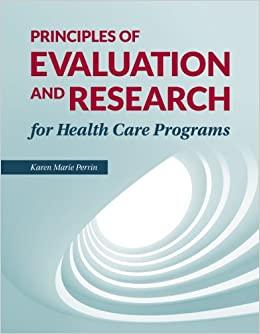
https://ebookmass.com/product/principles-of-research-andevaluation-for-health-care-programs/

The Prophet Of Modern Constitutional Liberalism: John
Stuart Mill And The Supreme Court 1st Edition Edition John Lawrence Hill
https://ebookmass.com/product/the-prophet-of-modern-constitutionalliberalism-john-stuart-mill-and-the-supreme-court-1st-edition-editionjohn-lawrence-hill/ ebookmass.com

Summative Evaluation
Process Evaluation
Outcome Evaluation
Impact Evaluation
Evaluation: Logic Models
Summary
Case Study: Healthy Food/Healthy People
Goal Statement
Objectives
Case Study Discussion Questions
Student Activities
References
Chapter 2 Ethics
Chapter Objectives
Key Terms
Introduction
Historical Background
U.S. Public Health Service Syphilis Study in Tuskegee Henrietta Lacks
Basic Principles of Medical Ethics
Ethical Links Between Research and Evaluation
Confidentiality of Medical Information and Research Data
Healthcare Providers: Medical Care Versus Medical Research
Physical Therapy Example
Nursing Example
Medical Example
Hospital Administration Example
Hospital Ethics Committee Example
Evaluation Example
Institutional Review Board
Informed Consent
Risk/Benefit Assessment
Selection of Individuals and Special Populations
Summary
Case Study: Diaz vs. Hillsbourgh County Hospital Authority
An Inquiry
The Next Step
The Lawsuit
Doctors’ Perspective
The Settlement
A Postscript
Case Study Discussion Questions
Student Activity References
Chapter 3 Determinants of Health
Chapter Objectives
Key Terms
Introduction
Historical View of Achievement in Health
Health Disparities
Social Determinants of Health
Physical Activity
Education
Access to Health Care
Resources: Safe Food, Safe Housing, and Employment
Using Healthy People 2020 to Study Health Disparities and
Social Determinants of Health
Summary
Case Study
Case Study Discussion Questions
Answers
References
Chapter 6 Qualitative Data
Chapter Objectives
Key Terms
Introduction
The Qualitative-Quantitative Debate
Qualitative Methods: Validity and Reliability
Types of Qualitative Design
Interviews
Observations
Case Studies
Phenomenology
Historical Documents
Content Analysis
Ethnography
Grounded Theory
Ethical Issues in Qualitative Research
Analyses of Qualitative Data
Data Organization
Coding Data
Data Display
Summary
Case Study
Summary
Case Study Discussion Questions
Student Activity
Case Study 1
Case Study 2
Case Study 3
Chapter 9 Data Tools
Chapter Objectives
Key Terms
Introduction
Data Classification
Categorical Data
Continuous Data
Data Organization
Descriptive Data
Graphic Presentation
Measures of Central Tendency
Mean
Median Mode
Normal Curve
Standard Deviation and Variance
Summary
Case Study
Survey Questions
Case Study Discussion Questions
Student Activity
Answers
References
Chapter 10 Populations and Samples
Chapter Objectives
Key Terms
Introduction
Populations and Samples
Probability and Inferential Statistics
Research and Null Hypothesis
Level of Significance
Sample Size Considerations
Margin of Error
Population, Sample, and Variability
Confidence Level
Budget and Budget Justification
Timeline
Probability and Nonprobability Samples
Probability Sampling
Nonprobability Sampling
Sampling Bias
Item Nonresponse Bias
Unit Nonresponse Bias
Summary
Case Study
Case Study Discussion Questions
Student Activity
Answers
References
Chapter 11 Inferential Statistics
Chapter Objectives
Key Terms
Introduction
Types of Statistics
The Need for Statistics
Inferential Statistics
Scientific Hypothesis
Research Questions
Null Hypothesis and Alternate Hypothesis
Basic Inferential Statistical Tests
Description
Overview of Evaluation
Budget
Budget Justification
Personnel
Graduate Students
Consultants
Focus Groups
Travel
Indirect Costs
Evaluation
Clinical Staff and Clinical Support Staff
Laboratory
Nonclinical Staff
Central Supply, Technical Support, Physical Plant and Environmental Services (CTPES)
Finance and Accounting
Board of Directors, Executive Administration, and Management
Patient Satisfaction
Draft of the Final Report
Evaluation of Clinical Staff and Clinical Support Staff
Evaluation of Laboratory
Evaluation of Nonclinical Staff
Evaluation of CTPES Staff
Evaluation of Finance and Accounting
Evaluation of Board of Directors, Executive Administration, and Management
Evaluation of Patient and Visitor Satisfaction
Recommendations for the Final Report
Student Activity
current literature on how the theories and models have been used as the framework for project development. The list of theories and models is not intended to be comprehensive, but rather an introduction to examples that are commonly used. Once the research questions or evaluation goals and objectives and an appropriate theory are selected, it is time to explore types of data. Chapter 5 defines the concepts of reliability and validity as well as random and systematic errors. The chapter ends with a detailed description of how to conduct a pilot test and why they are essential. Chapter 6 provides a detailed discussion of qualitative data including types qualitative designs, potential ethical issues, and analyses utilized in qualitative data. Chapter 7 presents some basic elements of research including the difference between basic and applied research, variables, group assignment, constructs, and operational definitions. After these concepts are understood, the three basic types of research design (true experimental, quasi-experimental, and nonexperimental) are defined and examples are provided to enhance understanding. Chapter 8 focuses on survey design, including types of surveys and how to select them. Various tests, inventories, and scales are introduced along with examples and reasons for selecting one survey type over another. A discussion of how culture and diversity influences data collection is included near the end of the chapter.
Chapters 9, 10, and 11 focus on basic skills related to data. Chapter 9 introduces how data are classified as categorical or continuous and then organized using frequency distributions. Building on this knowledge, the concepts of measures of central tendency, the normal curve, standard deviation, and variance are explained in detail with plenty of examples. This chapter serves as the foundation for understanding the next two chapters. Chapter 10 describes terms related to population and samples. There are three main topics covered: sample size considerations, probability and nonprobability samples, and sampling bias. Each topic deserves important consideration when determining the sample size needed for any evaluation or research project. Chapter 11 introduces inferential statistics and defines the terms scientific hypothesis, research questions, null hypothesis, and alternative hypothesis. The next section presents basic statistical tests (e.g., chi-square, t-tests, and correlation coefficients). The chapter ends with a discussion of type I and type II errors.
The last chapters provide skills related to budgets, reports, and presentations, and the text culminates with a case study. Chapter 12 is divided into two sections. The first section describes various types of budgets with examples to practice basic skills. Budget justifications are also presented. The second section defines the types of cost analyses and how each type is used. Chapter 13 illustrates several ways to present results including abstracts, executive summaries, reports, manuscripts, posters, and verbal presentations. Chapter 14 is a lengthy case study reinforcing all aspects presented in this book.
